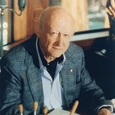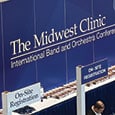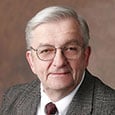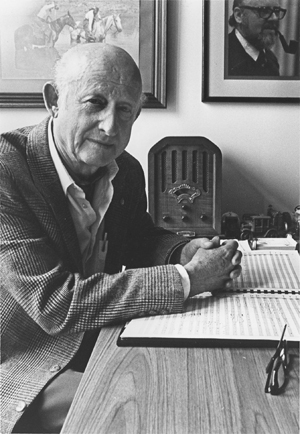 Over the years, Francis McBeth shared his ideas in his many thoughtful and inspirational articles for The Instrumentalist. As we remember his amazing legacy and influence on music education, we offer a second installment of selected excerpts; the first ran in the February issue.
Over the years, Francis McBeth shared his ideas in his many thoughtful and inspirational articles for The Instrumentalist. As we remember his amazing legacy and influence on music education, we offer a second installment of selected excerpts; the first ran in the February issue.
Never be Dull
As you attend clinics and conduct bands across the country, what do you feel is the single biggest problem with bands today?
Interpretation. Much music is boring because of wrong interpretation. Wrong interpretation can make a good piece dull, and the greatest crime in teaching is to be dull. The problem is that technology took over. Now we’ve got to have technology; we’ve got to have good subdivision, balance, and pitch. but technology without musicality is just boring. It’s not a musical experience, it’s a competitive experience.
When you say interpretation, what specifically are you referring to?
Interpretation is the recreation of the composer’s intent, and 99 percent of this intent is written on the page. It is not a situation where the conductor has the prerogative to use his own interpretation.
The secret to interpretation is volumes [dynamics]. Interpretation is 20 percent tempos and 80 percent volumes.
In rehearsal I work on interpretation even before the notes. I don’t care how good you are, if you don’t have interpretation you might as well have not played.
What can band directors do to improve interpretation?
Number one, you must understand what the music says or does, and then you must change your attitude toward musicality. It’s a step beyond technique.
Bad conductors conduct the score and not the band. They should try rehearsing from memory and get their head out of the score.
And you must use body effects when you conduct. Your body must do what the music does. Exaggerate everything in your conducting, and don’t mirror your hands. Mirrored hands destroy the importance of your left hand. The left hand should say, “Band, look up, I have something to tell you.”
On Programming
There is absolutely nothing in this world more boring than a poorly programmed concert. I hate to says this, but there aren’t many band concerts I’d drive across town to listen to because they are so boring. And I love band music.
People tend to program what bands can play with little regard to the order or overall effect. You’ve got to program dramatically. You’ve got to get the audience’s attention at the start, and then you have to use a slow work in there somewhere.
Slow music is where your band learns tone quality, breath support, interpretation, and balance. If you don’t have a slow piece on your concert, you’re missing a large area of teaching.
With my clinic bands our programs are a little shorter than regular concerts. I usually do five pieces: an opener, a slow piece, a large work in the middle, a light number, and a large work at the end.
I never do an encore. I think an encore is the worst thing you can do. The audience likes to know when they can go, and you should leave the audience wanting more. (1978)1
Excitement in Rehearsals
Discipline is the first order of business. A rehearsal should have an air of tension, and you can get it two ways: through fear or through excitement. Both are effective, but you can lose both ways.
With an atmosphere of pure fear the students get so tense that they never do well on a concert. With excitement they can get so high, you’ll never pull them down.
I prefer the excitement approach, but with the ability to tack a kid’s hide to the wall when needed and then get back immediately to what you were doing. I think of it as the Dr. Jekyll–Mr. Hyde approach. (1978)1
* * * *
I realize that I am in the minority on a final aspect of score study, that of marking the score. When I was young I marked much of the score because I was taught to do so. I found that my usual markings in an hour’s work caused me to spend more time reading markings than listening because the eye and ear do not work together. Once the eye goes to the page, the ears shut down about 40%. It was a great revelation to me that if I had to mark the score, I didn’t know the score. I recently read an article on how to mark a score, but I feel that if you need to mark the score, you do not know the composition. We are not learning a score; we are learning a musical work.
Except for enlarging the numerals in multiple meter changes, one must know all the things that are usually marked. I realize that this may be heresy, but I believe that a marked score is an unlearned score. To a lesser degree this is also true with the players’ individual parts. (1990)2
Evolution of Music Education
What is your view of music education today?
Instrumental pedagogy hit its zenith in the late 1970s, when we had high school bands playing better than turn-of-the-century professionals. In the 1980s the level of performance topped off; and judging by the all-states I have conducted in the last few years, it has taken a slight down-turn.
This is not because directors are not doing as well, but because of factions and problems within the public school system. Public schools in much of America are in such disarray and the attempt to correct them has caused such confusion as to priorities that music education has been set back. Our problem now is justifying music programs and convincing administrators that music is not an extracurricular activity. Music in the Texas schools has been hurt because of the H. Ross Perot bill, which was dubbed “no pass, no play.” This bill was an honest attempt to require academic achievement before students participate in extracurricular activities. Its disastrous effect on music education was a result of the Texas legislature thinking that music was extracurricular: they only observed bands at football games, and it seemed logical to them to categorize bands with pom-pon squads. If a first chair clarinet player failed one course and made A’s in all others, he could not perform at a contest with the band. If music is extracurricular, then Harvard University has an entire school of extracurricular activity. Music is one of the oldest courses of study in the world and is just as important as mathematics for a junior high school student.
Do you think we can turn this situation around?
One challenge is to educate administrators on the importance of music study, but retaining more junior high players may be even more important. In this day of slick commercial music, the music experience has got to be more exciting than much of it is today.
I think we would be shocked if we knew students’ reactions to much of the music that is played: they are really quite bored with it, and I don’t blame them. Too many directors choose music neither they nor the students really like. It’s chosen because it fits a minimum instrumentation or shows off a few skilled players at contests.
When my son was in junior high school, his band played a concert of canned rock, which the kids loved; marches, which they thought were all right; and folk song suites, which bored them but which parents thought they should appreciate. It was that night I decided to write Canto with its clapping and wood clackers. If composers do not write some exciting concert music for junior high students, we will lose them.
I think many composers take the wrong approach to junior high music. They feel that simple rhythms and conservative registers constitute approachable music. The direction should be writing more musically challenging music but tailoring it to the ease of fingerings and the characteristics of each instrument: in other words, simplicity of mechanics as opposed to simple music. This is the difference also between Tchaikovsky and Prokofiev; Prokofiev wrote at the piano and then scored the music, which is very hard to play. When Tchaikovsky wrote, he wrote for each instrument and knew what that instrument could do.
How do you feel about today’s band literature?
When Clifton Williams won the first Ostwald Competition in 1956 for Fanfare and Allegro, band music was getting exciting. Then came Barney’s Incantation and Dance, more Persichetti, then Martin Mailman’s Liturgical Music and the Geometrics Series, a few things of Lo Presti, then Claude Smith’s Incidental Suite. You notice I left myself out of this period because of Southern modesty. Hanson, Schuman, Mennin, and others were seeing the possibilities of wind music. The biggest spurt in the literature came from Nelhybel – a real European into the fray. His Symphonic Movement and Requiem are two of the very best works ever written for band. What an exciting time for us, and it lasted well into the 1970s. (1991)3
* * * *
When Frederick Fennell created the wind ensemble and chose the name, he performed one of the most ingenious acts of the 20th century. Fennell saw into the future. He saw a coming repertoire for the winds. He was well aware that the name band was a four-letter word to many serious musicians. He wanted to present serious wind literature to audiences, but realized that the term band was an albatross around the neck of many people because of the past. Every wind conductor in the United States is indebted to Frederick Fennell, more than any other man, for improving our status with the serious music community. What he did was a stroke of genius. History will be very kind to Fred. (1992)4
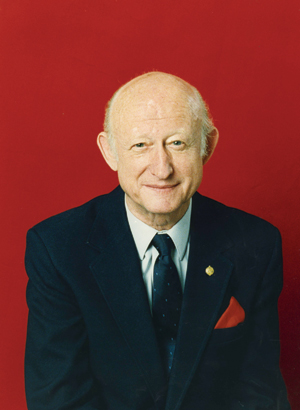 Volume
Volume
A composer speaks through many techniques, but the one most used is volume variance, with dissonance running a close second. Volume variance covers much more than louds and softs and includes most articulation markings, and goes through style and down to phrase endings. However, let’s not get complicated and stay with louds and softs and the graduation between them. Incorrect volumes will kill the composer’s intent faster than anything other than an absurd tempo. Even slight tempo changes can harm it. I have a tape on my desk on which the slow tempos are ten counts too fast and the fast tempos are ten counts too slow; it destroys the entire effect. Why is slow music usually conducted too fast?
A few years ago I was in the audience when an excellent honor band performed a work of mine. The tempo was excellent and all the technical aspects were good, but the pianissimos were mezzo-piano and the fortissimos were mezzoforte. I don’t know when I was ever more embarrassed to take a bow. The work is a dramatic work that I am fond of, and it sounded silly and made no sense. This isn’t a rare occurrence; it happens more often than not. (1990)2
Percussion Volume
Every time I ask for more volume from a timpanist, the player will immediately switch to harder mallets. Young timpanists have the mistaken belief that volume is controlled by the density of the mallet. I then have to waste more precious rehearsal time asking the player to switch back to the original mallets and just play louder. They always give me a quizzical look. Timpani volume is controlled by muscle, not by the hardness of the mallet.
The quality of bass drum and timpani tone has truly deteriorated over the last decade, and it is caused primarily by those infernal hard mallets. The quality of the bass drum and timpani tones is changed dramatically by mallet density. The very hard mallets, which seem to be the choice of young timpanists, produce a cold, secco clap sound that I really dislike. The bass drummers have no choice and simply use whatever mallets they have.
I have asked several percussion teachers I hold in high regard when this trend toward harder mallets began and what caused it. Each says that it started with the corps. Before readers take this as criticism of the corps and corps-style marching, they must know that I am a great supporter and fan of these groups. Many band directors of my generation blame corps and corps-style shows for all manner of evil effects on the band. I would rather see a corps or corps-style show than any other type of field show, including the Tattoos in Europe. I think a corps-style show is the most exciting and interesting instrumental show that has ever been put on a football field, but as with good medicine, there are both up and down sides. One of the up sides is that corps and corps-style shows have trained an abundance of keyboard players, few of whom were present in the 1950s and 60s. One down side is that corps equipment is considered suitable or even desirable for the concert stage.
This is most readily seen in the hard plastic xylophone mallets, which give a bright crisp sound on the football field; but on the concert stage they make the xylophone sound like someone is playing on bottles. On the concert stage the hard rubber (black) mallets give the only acceptable sound. I fear that many young band directors’ ears have been tuned to the marching percussion sound and may never have heard the concert difference.
In January of 1996 I worked with the Marine Forces Pacific Band in Hawaii, which had a wonderful bass drum sound. When I asked their leader C.W.O. Timothy Smith, he explained that they were using a gong mallet. I was so pleased with this sound that a month later I used a gong mallet on the bass drum with the Texas All-State Band. After the concert I received four separate comments about the excellent bass drum sound.
Conductors must not just accept any mallet or beater that a player happens to pick up. It is far better to have a distinctive timbre in your ear and force the player to achieve it. (1996)5
* * * *
Many years ago I heard the University of Michigan perform the Pines of Rome. The volume and power coming off the stage in the last movement felt as though I was being pressed against my seat. It was a memorable performance and convinced me that a band cannot play too loudly if it doesn’t lose tone, pitch, or balance.
A term that causes confusion is the admonition to focus the sound. Recently, at a band clinic in my area, I heard a clinician start each rehearsal by telling the college band to focus their sound. At one of the breaks I approached the first trumpet player and asked him what the term meant to him. He replied that he didn’t understand what it meant. I asked three other players and got the same answer. When I started asking band directors what it meant, they all stammered for a while and gave various answers, the majority of which fell in three categories: pitch, balance, and tone. If this is the case that it deals with one of these three, why not use those terms: we all know what they mean. I think that when the word focus became a common buzz word, especially with athletes, I guess musicians don’t want to be left out.
Another term that is misused is the name of the form ABA. It took me a while to understand the reason for its misuse. I finally realized that what they really meant was fast-slow-fast. A fast-slow-fast form is not necessarily ABA. For it to be ABA, the B section must be a new melody or motive completely different from the A section. I first realized this misunderstanding when I mentioned to a director that I had never used the ABA form, and he said that I had and he had played it. I asked him the name of the piece and he replied Battaglia. I told him the form of that piece was AA1(aa2), but he said it was fast-slow-fast. It then came to me that this was the confusion. An ABA form can also be slow-fast-slow, or fast-slow-fast, but ABA has nothing to do with the tempo. I have read reviews of works that the reviewer has mislabeled ABA when they are not. Remember that the format of fast-slow-fast can be ABA, but it is usually not in the 20th century. (2001)6
Creativity and Composing
The secret of composing is three-fold. A composer must form a plot (plan of events), choose the notes, then rewrite to tighten it up. The plot, scenario, or direction of a work must come before any notes. Notes are not the problem, there are only twelve of them. Student composers try to just scotch tape measures together before deciding what to do within the entire piece. It is very difficult to start a work if you don’t know how it will end. I always decide the endings before writing the beginnings. If I don’t know the destination, it is impossible to plan the trip, much less the point of embarkation.
The next, and more difficult choices are the inner plot and direction the composition will take, or the development of the materials that will be chosen later. This is the reverse of the procedure most people perceive; they assume that the materials are chosen before deciding on the course of development. If the materials are chosen before the course of development, the composer is put in the situation of laying brick before plans for the house are drawn.
Choosing the notes is the most laborious process in the act of composing, but again the medium, plot, and attitude dictate many of the choices. The worst possible method is to write “piano music” and force it into another medium. In a composition for orchestra a note is never written without knowing which instrument will play it; consequently, orchestration plays a large part in note choice. Composers never orchestrate music after it is written; they compose it orchestrated.
When choosing the pitches, the hardest task is in choosing the dissonant ones. Choosing consonants is quite easy, choosing correct dissonance is very difficult. A composer speaks in many ways, using many tools, but volume variants and dissonance may be the most important and expressive tools of all. The use of dissonance and its control may be the most important element of compositional craft. The use of dissonance is the major ingredient in music direction with tessitura and rhythm next. From Palestrina to Bach to Shostakovich, it is the controlled use of dissonance that sets these works apart from lesser composers.
* * * *
The creative world offers a lifetime of pleasures, moments of high exhilaration, and ultimate contentment. What it affords the creator is beyond price. I asked before why there is a desire to create. We create primarily for ourselves, though most people would think it is for others. I truly believe that Beethoven would not have cared if his scores had been placed in his casket. A true creator never considers posterity. Posterity is a 19th-century concept derived by consumers. When a creator is gone and his works remain, all the better, but it is not why they were produced.
The creative world is a sacred place where we all pilgrimage for refreshment. The creative world is a fountain which provides us with the contentment, joy, excitement, fulfillment, and beauty that gives life quality and meaning. (1994)7
Hard Work
Do you follow a regimen while working on a composition?
Composition is really much different than my freshman composition majors thought it was. You have to know where the whole piece is going before you start. I mean the scenario, not the notes. I have to know how a piece will end before I start it. That doesn’t mean I can’t change my mind. How it ends has so much to do with how the piece develops. Students sometimes write in what I call the scotch tape method. They go in a practice room and try to find the first chord. Once they have that they try other chords until one fits; now they have two chords. They scotch tape chords together and end up with nothing that sounds bad but nothing happens either. Nearly all beginning composers start that way, but you really must start with an idea of the whole piece. I used to have students graph on paper where the piece was going, where it would climax and so forth.
I write every night from 10 pm to 2 am, and I’ve worked that way for 40 years. Probably every musician has one piece in him, but if you want to compose for a lifetime, you have to work at getting the ideas. If you wait around for inspiration, you’ll spend your life on a couch with an afghan. Jack Douglas, perhaps the greatest comedy writer ever, said that he spent his whole life staring at blank paper. The term inspiration is often used incorrectly. I think inspiration is the inspiredness to actually write or to create sound. You have to work at developing an idea or it will not come. You have to call the muse up, not wait for it to suddenly appear. Only seldom does the muse come without any work.
My desire in composition is to be the Ernest Hemingway of music. Of any writer, Hemingway had the ability to say the most in the fewest words. He achieved this out of necessity. While in Paris working for the St. Louis Dispatch, he had to cable his stories back to the United States and paid for this out of his own pocket. He gleaned out as many words as possible because fewer words meant more profit. He called this system cable-ees and the French called it cablise, to say the most you can with the fewest number of words.
The 20th century development of the motive lends itself so well to this cable-ees style. If Dumas had written For Whom the Bell Tolls, he might have said, “In the summer of 1935 when the Loyalists and the Republicans….” Hemingway writes “There was a bridge” – a thousand times more dramatic. If Dumas had written Moby Dick, he might have written, “In the Nantucket fishing village of….” where Melville wrote “Call me Ishmael.” Beethoven killed the introduction to music with his Third Symphony, which uses only two chords to introduce the piece.
Can composition be taught?
I love to teach and would rather teach than eat, but the one class I liked less than any other was composition. If I had a great student, it was a joy. Teaching someone who can’t imagine is impossible. They will come in with four measures and say I just don’t know where to go from here.” I want to say to them, “Have you thought about another field?” Ron Nelson says we can only teach people to be composer-like, we can’t teach them to be composers. If I could guarantee students that I could teach them to compose, there would be a line from here to Los Angeles. It is the same in painting; there has to be talent and imagination.
I was fascinated to learn that you still hand copy all of your parts.
I copy my own parts because I want to see each part. When I first started writing, my brass parts were three pages long and the woodwind parts were one page, and that’s not right. With a score you don’t see that. When I copy a part, I can see that this poor person will be bored out of his mind. Surely I can improve this part without altering the music, and often an improvement to one part improves the score as a whole.
How much did being a conductor before you began to compose influence the way you compose?
This helped but not nearly as much as being an instrumental teacher. I taught music theory and composition at Ouachita University for the past 40 years, but the first 10 years I taught all of the woodwinds, brass, and percussion. This was typical of most small colleges in those days. Instrumental teaching affected my composition because I learned what each instrument could and could not do. I often alter the way I write for fingering reasons.
If my Chant and Jubilo were transposed up a step, it would triple the difficulty. At the end of the Jubilo the trombones have an ostinato in eighth notes that is playable because there is no change of slide positions, but this didn’t happen by accident. In my Masque there is an ostinato in the trumpets that sounds very difficult, but it is all one finger and open with the exception of the bottom note, which is first and second valve. If that were moved up or down a step, it would be extremely difficult. I can always identify composers who write music for the piano and orchestrate it later. Studying orchestration is really a back-door approach. Composers do not orchestrate, they compose orchestrated. If I don’t know what instrument will play a note, I don’t write the note.
I never send a piece to the publisher until I’ve performed it at least five times. I believe that the easier a piece is to perform, the more it will be played. What every composer wants is more performances. It isn’t a question of seeking more money; composers want performances. The trick is to write something that sounds as hard as nails but is easy to play. (1998)8
References
1 Music Dynamo, An Interview with W. Francis McBeth by Dana Davis, February 1978, p. 39.
2 The Score, Mechanics of Preparation, by W. Francis McBeth, May 1990, p. 8.
3 Band Music and the Paper-Plate Mentality, An Interview with W. Francis McBeth by Roger Rocco, December 1991, p. 12.
4 Assessing the Wind Ensemble, by W. Francis McBeth, March 1992, p. 27.
5 It’s a Hard Life, At Least the Last Ten Years, by W. Francis McBeth, August 1996, p. 80
6 Clarity in Musical Vocabulary by W. Francis McBeth, December 2001, p. 12.
7 The Creative World, by W. Francis McBeth, November 1994, p. 12.
8 It’s All in the Score, An Interview with W. Francis McBeth by Jeffrey Renshaw, August 1998, p. 10.
